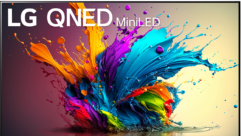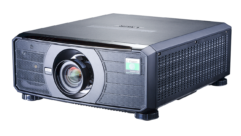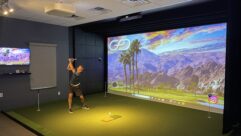LCD AND DLP PROJECTORS invade the boardroom
Oct 1, 1998 12:00 PM,
Peter H. Putman
There was plenty of dazzle and technology to see at INFOCOMM this pastJune, but one of the more significant developments was not entirelyobvious. To notice it, you had to attend the panel discussions and talk todealers/installers on the floor. The trained observer could also seeevidence in several manufacturer booths, if he looked in the right places.What is this emerging trend? It is simply a flood of full-featured videoprojectors for the rapidly-growing retro/upgrade A-V installationmarketplace. “Big deal,” you might say. “I’ve been installing CRTprojectors into retros and upgrades for several years. What’s so differentnow?”
Well, the different part of it is the availability of single lens,set-it-and-forget-it LCD and DLP projectors that offer boardroomconnectivity, XGA (1,024 X 768) or better native resolution, powerzoom/focus/lens offset functions, good quality NTSC/PAL video, 700 to 1,500ANSI lumens of brightness, a small profile with weight under 50 pounds(22.5 kg) and a price tag under $20,000. The combination of features andprice constitutes a paradigm shift in anyone’s book, particularly thosedesigners and installers looking to upgrade older schools, colleges andoffice buildings. In fact, some university in-house A-V departments arepurchasing these projectors as roll-around units to be pushed fromclassroom to auditorium as needed instead of trying to mount a permanentprojector/interface system in stucco or older plaster-walled/ceiling rooms.
Anyone can playPerhaps the most appealing aspect of these products is their simplicity ofoperation and minimal servicing requirements. All models boast ofauto-synching circuits that will lock-up and display anything from 525-linevideo to UXGA (1,600 X 1,200) RGB signals. Instead of having to convergethree CRTs, a small amount of time is spent fine-tuning the projector’shorizontal sync clock and phase controls, then saving the settings tomemory.
These features are not lost on staging and rental companies, either.Conventions and corporate business meetings often mean a myriad of notebookand desktop computers coming into hotel ballrooms, convention centers andbreakout rooms. The advantages of a mid-sized projection system with fullconnectivity and graphics/workstation resolution compatibility are obvious,as are the cost savings in setup and tear-down time.
If one of these projectors is sold into a permanent installation,convergence and alignment essentially become non-issues. The onlymaintenance required will be an occasional lamp change and a thoroughcleaning of the projector’s dust filters. Lens adjustments and imagetweaking can be done (for the most part) by the end-users. Other thanchanging the remote control’s batteries, there will not be much for adealer to worry about.
Intense light output appeals to customers stuck with an unused conferenceroom and recessed fluorescent fixtures on a wall switch. It is also likelythat same conference room will also have windows with sheer drapes orineffectual/broken blinds, and of course, it is bound to be painted whiteor off-white (if it does not have paneled walls with a hard white ceiling).
Classroom users need the extra light (not to mention several lens options)for long, front-projection setups often demanded by professors andteachers. An output of 300 lumens may work great at 15 feet (4.6 m), butmoving to 30 feet (9.2 m) means quadrupling light output to maintainequivalent brightness (in the neighborhood of 1,200 lumens).
The class of ’98I recently tested several of these boardroom boxes in my studio and found alot to like about them. Sanyo was the first company to really drawattention to the category with the PLC-9000N, a 37 pound (16.7 kg) nativeXGA projector with power zoom/focus, motorized lens shift and a wealth ofconnector options including both 5-BNC and 15-pin RGB, composite, Y/C andeven YUV video inputs. Optional plug-in input cards further extend theusefulness of this projector, which is suitable for both roll-around andfixed-installation use.
Mitsubishi upgraded its LVP-X100 to the XGA-resolution LVP-X200, which issmaller at 22 pounds (10 kg). It also provides a motorized focus/zoomadjustment and two sets of 15-pin RGB and composite-Y/C video connectors.Ditto In Focus’ Lite Pro 1000, a little larger than the X200 at 24 pounds(10.8 kg). It offers XGA resolution, three RGB connections (includinganother 5-BNC rack) and separate composite and S-Video jacks on each videoinput.
A product that has garnered even more attention is Hughes-JVC’s DigitalGraphics G1000 with SXGA (1,280 X 1,024) native resolution and two RGBinputs (5-BNC and 15-pin) plus composite, Y/C and YUV video. EvenElectrohome’s compact EPS-1024 (made by Fujitsu) has a 5-BNC/15-pin RGBlineup and native XGA polysilicon LCDs.
All but the Hughes-JVC projector generated in excess of 1,000 ANSI lumens,and the PLC-9000N peaked at nearly 1,600 ANSI. Contrast ratios on theSanyo, Electrohome and In Focus boxes exceeded 130:1 ANSI, and brightnessuniformity was no lower than 66% on any model, meaning viewers would see abright, evenly lit image.
Of course, the critical measure of a boardroom-quality projection system ishow well it syncs up to a variety of scan rates and image sizes. I used afine “H” pattern from Extron’s VTG-200 test generator to see how well theautomatic image sizing and pixel clock circuits worked on each projector.In all cases, lower-resolution RGB images locked up with minimal fussingand tuning. In fact, regular composite and S-Video looked quite good on allfive projectors; in particular, the color quality and crispness wasoutstanding on the G1000 and PLC-9000N.
That is not to say that every signal I introduced looked picture perfectthe first time. In fact, some of the projectors had trouble with variationsof their own native display rates. In particular, low XGA scan rates likeXGA-4 (48 kHz/60 Hz) and XGA-5 (57 kHz/70 Hz) were no-brainers for each ofthe tested models. XGA-6 (63 kHz/72 Hz) was another story even though thehorizontal and vertical picture rates fell within each projector’spublished specifications.
The problem I observed was sync banding, usually corrected by adjustingeach projector’s pixel clock. But some projectors could not produce a cleanpicture at this rate without a fair amount of tweaking. Although this mightnot be a problem with photographs or images with large detail, small textand lines found on CAD drawings, spreadsheets and organizational chartswould appear blurred or smeared.
Downconverting SXGA (1,280 X 1,024) is another trick these projectorsperform, using pixel decimation and remapping techniques. Again, the lowerscan rate SXGA signals (from 48 KHz/60 Hz to 64 KHz/60 Hz) generally lockedup cleanly, but higher horizontal scan rates proved problematic. Theexception was the G1000, which has no need to scale SXGA; its nativeresolution stands at 1,365 X 1,024 pixels, sufficient to handle just aboutevery computer display card you can imagine, plus the 720 progressive HDTVstandard line for line.
The choice is yoursAs wonderful as these projectors sound, they are not for everybody. Someinstallations and customers still need the precise imaging and colorquality of a traditional three-gun CRT, although the size of that market iscertainly diminishing. Pixel decimation and remapping is a tricky science,and there are clients who will never be satisfied with the results untilprojectors with native resolutions exceeding 1,280 X 1,024 become available.
On the other hand, CRT engines require more care than the average LCD/DLPprojector, which is why they are losing ground in time-sensitiveapplications like staging and rentals as well as set-it-and-forget-itmarkets (retros, upgrades and in-house A-V departments at schools andcolleges). The flood of projectors shows no signs of ebbing as reflectiveLCD and micro-lens LCD technologies come into vogue. It will only getcrazier as more SXGA imaging devices come to market, particularly TexasInstruments’ 1,280 X 1,024 DMD devices, which are scheduled to startshipping late this year.
Consider this for a moment: Five years ago, the average portable LCDprojector weighed about 30 pounds (13.5 kg), offered VGA resolution (plusvideo) and could produce somewhere between 150 and 200 lumens ofbrightness. That is 6.6 lumens per pound.
Today, we have products like NEC’s MultiSync MT1035; technically a desktopXGA projector at 17 pounds (7.6 kg) and minimal RGB/video inputs, but it isable to crank out more than 1,300 lumens for less than $14,000. That worksout to 76 lumens per pound, which is 11 times more than 1994’s technology(an increase of more than 1,000%). Electrohome’s EPS1024 weighs only 15pounds (6.6 kg) and generates 77.5 lumens per pound at 1,162 ANSI.
On average, desktop XGA projectors are capable of 700 to 1,000 ANSI withoutbreathing too hard, a fact that did not go unnoticed at INFOCOMM ’98. Manyof those portables are sure to wind up in small conference rooms andclassrooms soon, replacing older multisync monitors and 7 inch (176 mm) and8 inch (202 mm) CRT boxes. Coupled with quick computer/video/audiointerfaces like Extron’s System 5cr (also aimed square at the retro/upgrademarket), there is indeed a paradigm shift happening in the A-V installationand rental markets.










